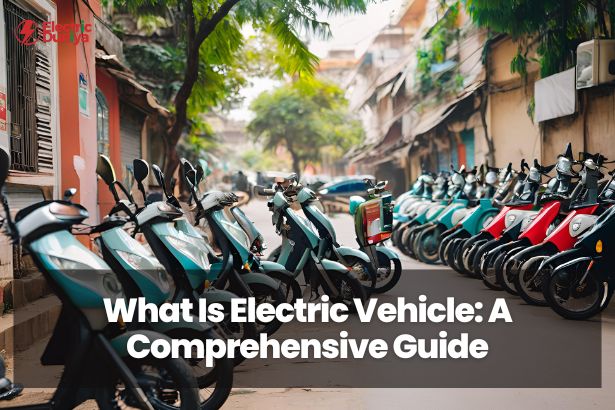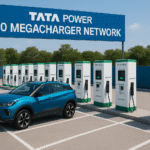Electric vehicles (EVs) are changing the car industry with their eco-friendly design. EVs use electric motors and rechargeable batteries instead of gasoline engines. This helps reduce pollution and noise from traditional vehicles.
The global trend is moving towards EVs in countries like the US, EU, China, and India to reduce emissions. Automakers are investing more in EV technology due to its environmental and economic benefits, rapidly growing the EV market worldwide.
This blog focuses on what electric vehicles are, how they work, and why more people are choosing them. It covers EV types, their environmental benefits, and tips to pick the best one for you.
Evolution of Electric Vehicles in India
India has been using electric vehicles for many years. The first electric vehicles appeared on Indian roads a long time ago. Still, these first attempts had trouble and did not become popular, unlike the UK’s early successes with electric vehicles.
Now, things have changed. There is a strong push to fight pollution. New technology for electric vehicles has improved, and the government is supporting these efforts. This change brings hope for cleaner air and less need for fossil fuels. It shows a path to a greener future for everyone.
1. The Early Days and Historical Milestones
Tesla brought a new spark to interest in electric vehicles (EVs) in the 21st century. But India has been part of electric mobility since the 1970s, including innovations involving nickel. One of the first steps was when electric buses were tested in Kolkata. Even though these efforts were small and not very successful, they set the stage for what was to come in India’s electric vehicle market.
Still, there were challenges. High technology costs, not enough charging stations, and low consumer knowledge made it hard for EV adoption to grow. The market stayed quiet for many years.
This began to change when the new century started. There was a fresh focus on caring for the environment and tackling climate change. Car companies, like Tesla, launched exciting electric car models. The Tesla Model S and Model 3 amazed people around the world and changed how many viewed electric mobility.
2. Recent Advancements and Government Policies
In recent years, India has seen a rise in people using electric vehicles, or EVs. This increase is due to better battery technology, lower prices for EVs, and helpful government rules. The Indian government knows that EVs can help reduce pollution and support a sustainable future. Because of this, they have started many programs and incentives to boost EV use.
One of these programs is called FAME II, which stands for Faster Adoption and Manufacturing of (Hybrid &) Electric Vehicles in India. This program aims to encourage more EV manufacturing and sales, making it easier for people to buy EVs. Due to these rules, many new startups are growing in the EV field. Traditional car makers are also starting to create electric cars.
As a result, many new cars and electric car models are now available in India to suit various budgets and needs. The government’s goal is to make India a major hub for EVs by 2030, showing their strong commitment to electric mobility.
What is an Electric Vehicle (EV) Technology?
Electric vehicle technology represents a significant shift in the automotive industry, moving away from traditional internal combustion engines towards electric motors. This transition not only reduces noise pollution but also decreases the reliance on fossil fuels, contributing to a cleaner environment.
Central to electric vehicles are battery packs, which store and provide power for models produced by companies such as Tesla and Hyundai. The increasing availability and advancements in electric vehicle technology are making them more accessible and appealing to consumers worldwide.
A key feature of electric vehicles is regenerative braking, a process that helps recharge the batteries while driving. By harnessing energy during braking, this technology not only enhances efficiency but also minimizes environmental impact, ultimately leading to lower carbon footprints.
Electric vehicles, including Mahindra models, come in various forms, including Battery Electric Vehicles (BEVs), Hybrid Electric Vehicles (HEVs), and Plug-in Hybrid Electric Vehicles (PHEVs), each offering unique benefits and functionalities.
The promising future of transportation lies in the widespread adoption of electric vehicles, paving the way for a more sustainable and eco-friendly mode of travel.
As advancements continue to be made in electric vehicle technology, we can expect to see further innovations that will revolutionize the way we move from place to place while reducing our carbon footprint on the planet.
1. How EVs Work: From Battery to Motor
The battery pack is indeed the heart of an electric vehicle (EV), responsible for storing and supplying the electrical energy needed to power the electric motor and inverter. Comparable to a fuel tank in traditional vehicles, it contains lithium-ion cells that hold electrons rather than gasoline.
When you step on the accelerator, the stored energy in the battery pack is released. This energy is transferred to the electric motor, where it is converted from DC to AC mechanical energy. The wheels are then set in motion, propelling the vehicle forward.
One notable advantage of EVs is their efficiency, largely due to regenerative braking. This innovative feature allows the electric motor to function as a generator when braking occurs. The kinetic energy generated from slowing down is captured and converted back into electrical energy. This regenerated energy is then sent back to the battery pack, effectively recharging it and extending the vehicle’s range.
Moreover, advancements in battery technology have led to increased driving ranges and faster charging times for EVs. Companies are continually investing in research and development to enhance battery performance and durability, making electric vehicles more practical and appealing options for sustainable transportation.
2. The Role of Lithium-Ion Batteries and Alternatives
Currently, lithium-ion batteries dominate the EV market due to their high energy density, relatively lightweight, and long lifespan. These rechargeable batteries have proven their mettle in various applications, from smartphones and laptops to powering electric vehicles.
| Battery Type | Advantages | Disadvantages |
| Lithium-Ion | High energy density, long lifespan | Cost, thermal management |
| Sodium-Ion | Abundant resources, low cost | Lower energy density |
| Solid-State | Enhanced safety, faster charging | Scalability challenges |
| Lithium-Sulfur | Higher theoretical energy density | Limited cycle life |
However, research into alternative energy sources for EVs is ongoing, driven by the desire for higher performance, lower costs, and reduced reliance on limited resources like lithium. Promising contenders include sodium-ion batteries, solid-state batteries, and lithium-sulfur batteries. These emerging technologies hold the potential to further revolutionize the EV landscape and accelerate the transition towards a more sustainable future.
Types of Electric Vehicles Available in India
The Indian electric vehicle market is growing quickly. There are many types of EVs now. They meet different needs and preferences. You can find fully electric models that run only on batteries. There are also hybrid options that use both electric and gasoline power.
This variety gives consumers a chance to pick what works best for them. They can consider their driving habits, budget, and how much they care about the environment.
As technology gets better and more people want EVs, we can look forward to new and exciting models. This will change the future of transportation in India.
1. Battery Electric Vehicles (BEVs)
Battery Electric Vehicles (BEVs) are a sustainable transportation solution that solely relies on electric power from rechargeable batteries, eliminating the need for internal combustion engines, including gasoline engines.
Notably, some of the well-known models in this category include the Tesla Model Y and the Hyundai Kona Electric. By operating without generating tailpipe emissions, BEVs play a significant role in reducing noise pollution and promoting environmental cleanliness.
As advancements continue to enhance electric vehicle battery technology and charging infrastructure expands globally, BEVs are gaining popularity as an eco-friendly mode of transport.
The increasing accessibility to EV charging stations and improvements in battery efficiency are driving more consumers towards embracing BEVs as a greener alternative for commuting.
Additionally, the development of fast-charging capabilities is addressing concerns about range limitations, making BEVs a practical choice for everyday travel while contributing to a more sustainable future.
2. Hybrid Electric Vehicles (HEVs)
Hybrid electric vehicles (HEVs) have gained significant popularity due to their innovative technology that combines an internal combustion engine with an electric motor. This unique blend allows HEVs to achieve impressive fuel economy and fuel efficiency, reducing emissions and contributing to a greener environment.
The Toyota Prius and Honda Insight are renowned examples of HEVs that have made a mark in the automotive industry for their eco-friendly features. A key feature of HEVs is their ability to recharge the battery pack through regenerative braking, a process that converts kinetic energy into electrical energy.
This efficient method enables HEVs to travel longer distances while consuming less fuel, making them a sustainable transportation option. Additionally, HEVs can seamlessly switch between the electric motor and petrol engine based on driving conditions, ensuring optimal performance and efficiency.
By harnessing the benefits of both electric and petrol power, HEVs offer a cleaner alternative to traditional vehicles without compromising convenience. Drivers can enjoy the flexibility of refueling at standard gas stations while benefiting from reduced environmental impact and lower operating costs in the long run.
As advancements in hybrid technology continue to evolve, HEVs stand out as a promising solution for environmentally conscious consumers seeking sustainable transportation options.
3. Plug-in Hybrid Electric Vehicles (PHEVs)
Plug-in Hybrid Electric Vehicles (PHEVs) are a smart combination of a parallel hybrid internal combustion engine, an electric motor, and a battery pack. This unique setup provides drivers with the flexibility to operate solely on electric power for short distances, making them ideal for urban commuting or quick errands.
When longer journeys are required, the vehicle seamlessly transitions to the combustion engine, offering extended range and convenience without the fear of running out of battery power.
One of the key features of PHEVs is regenerative braking, a technology that captures energy typically lost during braking and stores it in the battery pack.
By harnessing this otherwise wasted energy, PHEVs can increase their overall efficiency, reduce emissions, and ultimately save fuel costs. This innovative approach not only benefits the environment by lowering greenhouse gas emissions but also offers drivers significant savings at the pump.
Models like the Hyundai Ioniq and BMW X5, as well as the Fiat 500e, exemplify the advancements in eco-friendly driving options available today. These vehicles strike a balance between versatility and efficiency, catering to drivers who prioritize sustainability without compromising on performance or style.
With more automotive manufacturers embracing the trend towards electrification, PHEVs continue to gain popularity as a practical and environmentally conscious choice for modern drivers looking to reduce their carbon footprint.
Charging Infrastructure in India
A strong and wide charging network is important for people to buy electric vehicles (EVs). India understands this and is quickly growing its EV charging network. This helps keep up with the rising number of electric cars on the streets.
There are public charging stations placed in city areas and along highways. There are also more home charging options available. EV owners can now choose from different charging methods that fit their needs and way of life.
These efforts to improve India’s EV charging system are key to reducing range anxiety and helping everyone switch to electric mobility easily.
1. Public Charging Stations: Availability and Types
Public charging stations are becoming more common in India. They give EV owners a simple way to charge their batteries while traveling. These stations are well-placed in cities, shopping malls, office areas, and along highways. They help make electric vehicles more accessible and practical.
There are different types of chargers for various needs. Level 2 chargers are often found in public places and charge faster than regular home outlets. For those who want to charge even quicker, DC fast chargers provide a large amount of power in a short time. This makes them great for long trips.
As more people demand public charging, the network will likely expand quickly. Both the government and private companies are helping build this charging infrastructure. This will make sure EV owners have enough chargers, making it easier to switch to electric vehicles.
2. Home Charging Solutions and Setup
For many EV owners, charging their cars at home is very convenient. Home charging lets them fill up the battery overnight. This means their vehicle is always ready to drive each morning. It also cuts down trips to public charging stations, making daily travel easier.
Setting up a home charger is simple. You usually need to call a good electrician to install a charging unit, also known as a wall box. These chargers provide electrical energy more effectively and at a faster rate than regular outlets. This leads to quicker charging times.
Homeowners who care about the environment can use solar panels to charge their EVs. By using energy from the sun, they can lower their carbon footprint and rely less on the electrical grid. This way, charging EVs with solar power shows how electric vehicles can help create a more sustainable future.
Benefits of Electric Vehicles
The benefits of electric vehicles go well beyond their stylish looks and modern technology. EVs provide many advantages that include environmental, economic, and social aspects. These benefits are leading the move toward electric mobility and changing the way we transport ourselves.
EVs help cut down harmful emissions and reduce reliance on fossil fuels. They also have lower costs to run and offer a quieter, more pleasant driving experience.
This makes them a strong option compared to regular gasoline cars. As technology improves and production costs drop, the advantages of EVs will stand out even more. This will help more people choose electric vehicles in the future.
1. Environmental Benefits
One big advantage of electric vehicles is that they can lower carbon footprints and fight air pollution. Unlike vehicles that run on gasoline, EVs do not release harmful pollutants into the air. This means they help create cleaner air and a healthier place to live.
By reducing the use of fossil fuels, electric vehicles are important for fighting climate change and supporting a sustainable environment. Switching to electric cars helps global efforts to cut down greenhouse gas emissions and reach carbon neutrality.
Additionally, electric vehicles help make our cities and towns quieter. They operate almost silently, which lowers noise pollution. This makes urban areas more peaceful and enjoyable to live in.
2. Economic Advantages for Indian Consumers
Electric vehicles (EVs) have many economic benefits for people in India, beyond helping the environment. The biggest benefit is that their running costs are much lower than those of gasoline-powered cars. Since electricity costs less than fuel in India, EV owners can save a lot on their daily travel and long trips.
EVs also have lower maintenance costs. They do not have complicated parts like spark plugs, oil filters, or exhaust systems. This means they don’t need servicing as often, which saves time and money for the owners.
In addition, the Indian government offers incentives and subsidies to encourage EV adoption. This makes buying new electric cars more affordable. These financial benefits, along with savings on fuel and maintenance, make EVs a great choice for those who care about costs in India.
Final Thoughts
Electric vehicles are a good option for the future. Thanks to better technology and help from the government, EVs are becoming more popular in India. Knowing about the different kinds of EVs and where to charge them is important for making a smart choice. Electric vehicles can help the environment and save money, which makes them very appealing to people in India.
By using EV technology, we can lower carbon emissions and create a cleaner planet. As the EV market grows, it’s important to keep learning about the benefits they provide for both people and the Earth.







